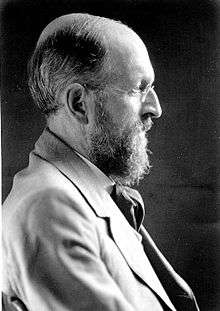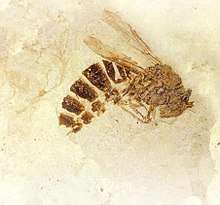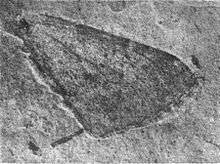Theodore Dru Alison Cockerell
Theodore Dru Alison Cockerell (1866–1948) was an American zoologist, born at Norwood, England, and brother of Sydney Cockerell. He was educated at the Middlesex Hospital Medical School, and then studied botany in the field in Colorado in 1887–90. Subsequently, he became a taxonomist and published numerous papers on the Hymenoptera, Hemiptera, and Mollusca, as well as publications on paleontology and evolution.
Theodore Dru Alison Cockerell | |
|---|---|
 | |
| Born | 22 August 1866 Norwood, Greater London |
| Died | 26 January 1948 (aged 81)[1] San Diego, California |
| Resting place | Columbia Cemetery, Boulder, Colorado |
| Nationality | English |
| Citizenship | United States |
| Alma mater | Middlesex Hospital Medical School |
| Spouse(s) | Annie Fenn Cockerell, Wilmatte Porter Cockerell |
| Scientific career | |
| Fields | Zoology, botany |
| Institutions | New Mexico Agricultural Experiment Station, New Mexico Normal University, University of Colorado, University of Colorado Museum of Natural History |
| Notable students | Charlotte Cortlandt Ellis |
| Author abbrev. (botany) | Cockerell |
| Author abbrev. (zoology) | Ckll.[2] |
Personal life
_and_Theodore_Dru_Alison_Cockerell_(1866-1948)_(cropped).jpg)
Cockerell was born in Norwood, Greater London and died in San Diego, California.
He married Annie Penn in 1891 (she died in 1893) and Wilmatte A. Porter in 1900. In 1901, he named the ultramarine blue chromodorid Mexichromis porterae in her honor. Before and after their marriage in 1900, they frequently went on collecting expeditions together and assembled a large private library of natural history films, which they showed to schoolchildren and public audiences to promote the cause of environmental conservation.
After his death he was buried in Columbia Cemetery, Boulder, Colorado.[4]
Professional life
Between 1891 and 1901 Cockerell was curator of the public museum of Kingston, Jamaica, professor of entomology of the New Mexico Agricultural Experiment Station. In 1900–03 he was instructor in biology at the New Mexico Normal University. While there he taught and mentored the botanist Charlotte Cortlandt Ellis.[5] In 1903–04 Cockerell was the curator of the Colorado College Museum; and in 1904 he became lecturer on entomology and in 1906 professor of systematic zoology, at the University of Colorado, where he worked with Junius Henderson in establishing the University of Colorado Museum of Natural History. During World War II he operated the Desert Museum in Palm Springs, California.[6][7]
Publications
Cockerell was author of more than 2,200 articles in scientific publications, especially on the Hymenoptera, Hemiptera, and Mollusca, and on paleontology and various phases of evolution, plus some 1700 additional authored works, including treatises on social reform and education. He was one of the most prolific taxonomists in history, publishing descriptions of over 9,000 species and genera of insects alone, some 6,400 of which were bees, and some 1,000 mollusks, arachnids, fungi, mammals, fish and plants.[8] This includes descriptions of numerous fossil taxa, such as the landmark study, Some Fossil Insects from Florissant, Colorado (1913). The standard author abbreviation Cockerell is used to indicate this person as the author when citing a botanical name.[9] In an obituary note that appeared in the Nature of Feb.14, 1948, R.B. Benson had observed that Cockerell "acquired the habit of hurrying his ideas and observations into print as soon as he could. The habit persisted throughout his long life, so that almost all his work appeared in the form of short papers."
Honors
A dorm in the Engineering Quad at the University of Colorado at Boulder and the moth Givira theodori are named in his honor.
Taxa
Taxa named by Cockerell include:
| Name | Year | Unit | Location | Notes | Images |
|---|---|---|---|---|---|
|
1906 |
Florissant Formation |
United States |
|||
|
1906 |
Florissant Formation |
United States |
A mason bee |
||
|
Archimyrmex rostratus |
1923 |
United States |
A myrmeciine ant |
||
|
1893 |
Extant |
a land slug genus |
|||
|
Dinopanorpa megarche |
1924 |
Khutsin Formation |
Russia |
A scorpion fly |
|
|
1922 |
Florissant Formation |
United States |
| ||
|
Protostephanus ashmeadi |
1906 |
Florissant Formation |
A crown wasp |
||
|
1906 |
Baltic amber & Florissant Formation, Colorado |
Europe |
An Eocene wasp genus |
 Palaeovespa florissantia | |
|
Tortrix? destructus |
1917 |
Florissant Formation |
United States |
A moth |
|
|
Tortrix? florissantana |
1907 |
Florissant Formation |
United States |
A moth |
|
| Trigona corvina | 1913 | Central America & South America | A stingless bee |
| |
References
- Gardner, Sue Ann, "Theodore Dru Alison Cockerell". Retrieved 5 November 2017.
- Cockerell, T. D. A. (July 1897) "Contributions to Coccidology.-II." The American Naturalist. Vol. 31, No. 367, pp. 588-592
- Cockerell, T. D. A. (July 1897) "Contributions to Coccidology.-II." The American Naturalist. Vol. 31, No. 367, pp. 588-592
- The Valley of the Second Sons
- Eugene Jercinovic (21 February 2008). "Charlotte Ellis of the Sandia Mountains" (PDF). The New Mexico Botanist.
- Young, Patricia Mastick (1983). Desert Dream Fulfilled: The History of the Palm Springs Desert Museum. Palm Springs, California: Palm Springs Desert Museum, Inc. pp. 24–25. LCCN 83080384. OCLC 19266381. LCC QH541.5.D4 Y68 1983
- The New International Encyclopaedia. Volume V. (2 ed.). New York: Dodd, Mead and Company. 1914. p. 534.
- "?". Archived from the original on 13 June 2007.
- IPNI. Cockerell.
External links
| Wikisource has original works written by or about: Theodore Dru Alison Cockerell |
| Wikimedia Commons has media related to Theodore Dru Alison Cockerell. |
